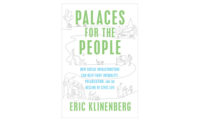Bartholomew Voorsanger is best known for museum projects, such as the Asia Society Museum renovation in New York (2001), and a series of sprawl- ing houses from Martha’s Vineyard to Montana. To his credit, the architect expounds on disappointments as well as successes. Describing a competition he lost—for a World War II museum in Poland—he tells Alastair Gordon that he “failed to understand the national culture and the intent of the jury.” He concedes that his rejected entry for the expansion of the Brooklyn Museum didn’t provide an iconic space. But most of Voorsanger’s candor is reserved for his personal life. Born in 1937 in Detroit, he and his twin brother, Neil, spent three years in the Hebrew Orphan Asylum of New York after their seamstress mother gave them up. They were occasionally “chosen” by foster families, and then returned to the facility weeks or months later. Voorsanger remembers the grim orphanage as a series of wards, set enfilade, and has always avoided such linearity in his work. At age 3, the boys were adopted by a prominent San Francisco couple named Voorsanger, known for their interest in the arts. But the damage had been done. Bart was a terror as a child—he once struck a teacher and had to be home-schooled; another time, he vandalized a neighbor’s marble mansion with black shoe polish. His twin, at age 11, blinded himself in one eye by firing a pistol.
But architecture, says Voorsanger, gave him an outlet. At 13, he saw Bernard Maybeck’s First Church of Christ, Scientist (1901) in Berkeley. Overwhelmed by its beauty, he decided to become an architect. After studying at Princeton and Harvard, Voorsanger worked for the urban planner Vincent Ponte in Montreal, then spent 10 years with I. M. Pei in New York before forming a partnership with Ed Mills in 1978.
His devotion to his work, he says, led to the breakup of his first marriage, to Lisa Livingston, with whom he had adopted a daughter and a son. He endured tragedies: his second wife, curator Catherine Hoover, died of cancer. His daughter was murdered, and her son was killed in a snowmobile accident. (Voorsanger is now married to the museum executive Peggy Loar.) Voorsanger & Mills won a number of important commissions including the Hostos Community College Allied Health Complex in the Bronx (1991), and a “garden court” joining sections of the Morgan Library on Madison Avenue (1992). But the partnership with Mills ended in 1989. “It was like being in another bad marriage,” Voorsanger recalls. And in a setback not mentioned in the book, the Morgan Library demolished the 10-year-old garden court to accommodate Renzo Piano’s 2006 expansion.
His firm, now called Voorsanger Architects, has completed such projects as the multiphased National World War II Museum in New Orleans (2009–2019), offices for the designer Elie Tahari (2003), and a number of houses distinguished by expansive roofs. Gordon sees the roofs, which often unfold like interlocking planes, as representing the shelter Voorsanger has been seeking since his childhood. He’s come a long way from the orphanage.





